Plastic Collective: A Case Study on Sustainable Business Strategies
VerifiedAdded on 2023/04/25
|19
|4947
|418
Case Study
AI Summary
This case study provides an in-depth analysis of Plastic Collective, a company founded to reduce plastic waste and promote sustainable economies. It examines the company's background, its importance in the Australian and international business landscape, and its sustainable strategies, including green innovation and value creation. The study identifies key sustainability-related issues faced by Plastic Collective, such as infrastructure and collection challenges, the negative impact of tourism, wildlife and habitat issues, and economic impacts. It also explores the application of sustainable theories like zero waste and balance theory, analyzes the firm's functions (planning, organizing, leading, and controlling), and offers recommendations for improvement. The case highlights the company's mission to convert plastic waste into useful resources and its commitment to environmental protection.

Plastic Collective
2 / 1 8 / 2 0 1 9
2 / 1 8 / 2 0 1 9
Paraphrase This Document
Need a fresh take? Get an instant paraphrase of this document with our AI Paraphraser
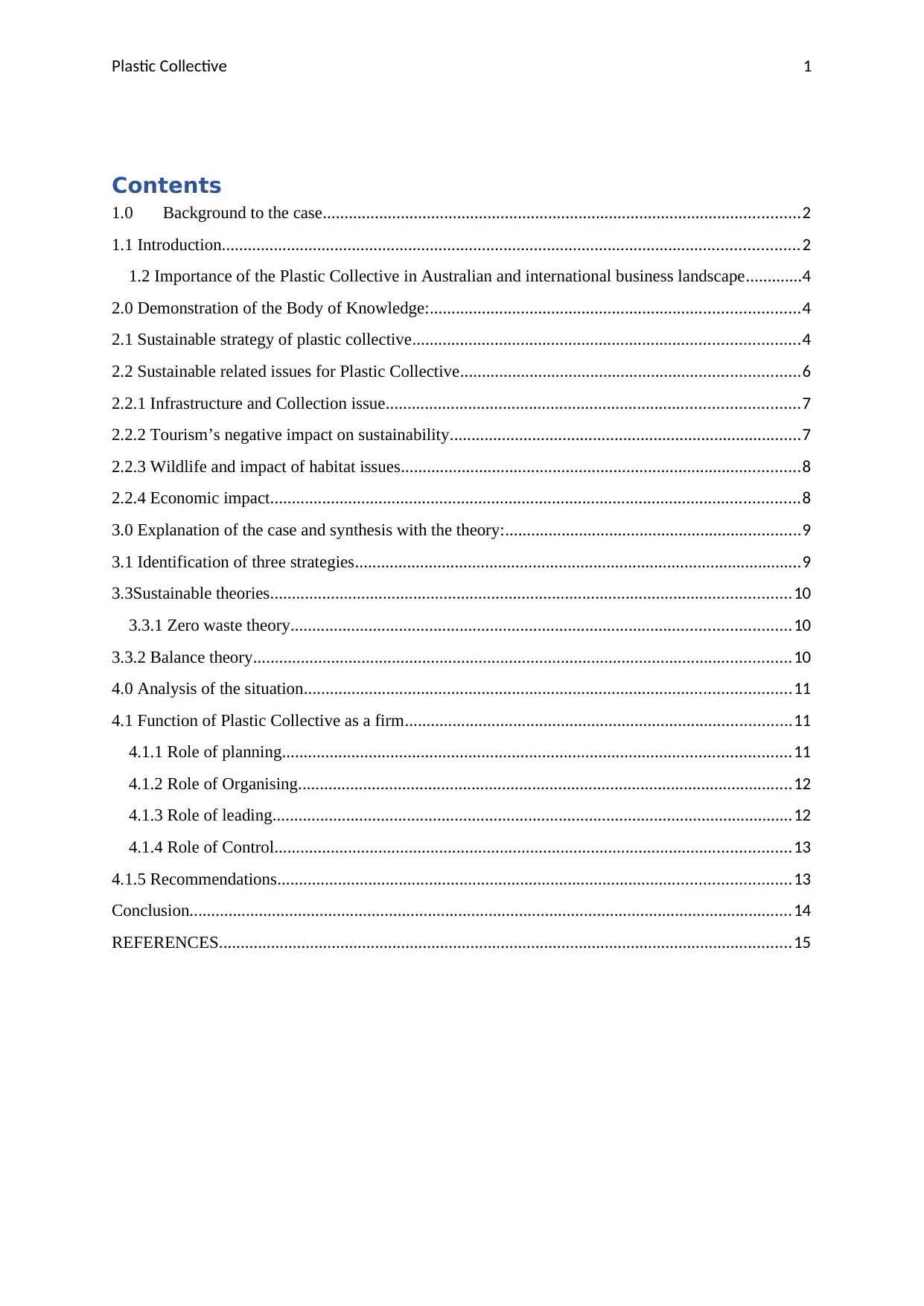
Plastic Collective 1
Contents
1.0 Background to the case..............................................................................................................2
1.1 Introduction.....................................................................................................................................2
1.2 Importance of the Plastic Collective in Australian and international business landscape.............4
2.0 Demonstration of the Body of Knowledge:.....................................................................................4
2.1 Sustainable strategy of plastic collective.........................................................................................4
2.2 Sustainable related issues for Plastic Collective..............................................................................6
2.2.1 Infrastructure and Collection issue...............................................................................................7
2.2.2 Tourism’s negative impact on sustainability.................................................................................7
2.2.3 Wildlife and impact of habitat issues............................................................................................8
2.2.4 Economic impact..........................................................................................................................8
3.0 Explanation of the case and synthesis with the theory:....................................................................9
3.1 Identification of three strategies.......................................................................................................9
3.3Sustainable theories........................................................................................................................10
3.3.1 Zero waste theory...................................................................................................................10
3.3.2 Balance theory............................................................................................................................10
4.0 Analysis of the situation................................................................................................................11
4.1 Function of Plastic Collective as a firm.........................................................................................11
4.1.1 Role of planning.....................................................................................................................11
4.1.2 Role of Organising..................................................................................................................12
4.1.3 Role of leading........................................................................................................................12
4.1.4 Role of Control.......................................................................................................................13
4.1.5 Recommendations......................................................................................................................13
Conclusion...........................................................................................................................................14
REFERENCES....................................................................................................................................15
Contents
1.0 Background to the case..............................................................................................................2
1.1 Introduction.....................................................................................................................................2
1.2 Importance of the Plastic Collective in Australian and international business landscape.............4
2.0 Demonstration of the Body of Knowledge:.....................................................................................4
2.1 Sustainable strategy of plastic collective.........................................................................................4
2.2 Sustainable related issues for Plastic Collective..............................................................................6
2.2.1 Infrastructure and Collection issue...............................................................................................7
2.2.2 Tourism’s negative impact on sustainability.................................................................................7
2.2.3 Wildlife and impact of habitat issues............................................................................................8
2.2.4 Economic impact..........................................................................................................................8
3.0 Explanation of the case and synthesis with the theory:....................................................................9
3.1 Identification of three strategies.......................................................................................................9
3.3Sustainable theories........................................................................................................................10
3.3.1 Zero waste theory...................................................................................................................10
3.3.2 Balance theory............................................................................................................................10
4.0 Analysis of the situation................................................................................................................11
4.1 Function of Plastic Collective as a firm.........................................................................................11
4.1.1 Role of planning.....................................................................................................................11
4.1.2 Role of Organising..................................................................................................................12
4.1.3 Role of leading........................................................................................................................12
4.1.4 Role of Control.......................................................................................................................13
4.1.5 Recommendations......................................................................................................................13
Conclusion...........................................................................................................................................14
REFERENCES....................................................................................................................................15
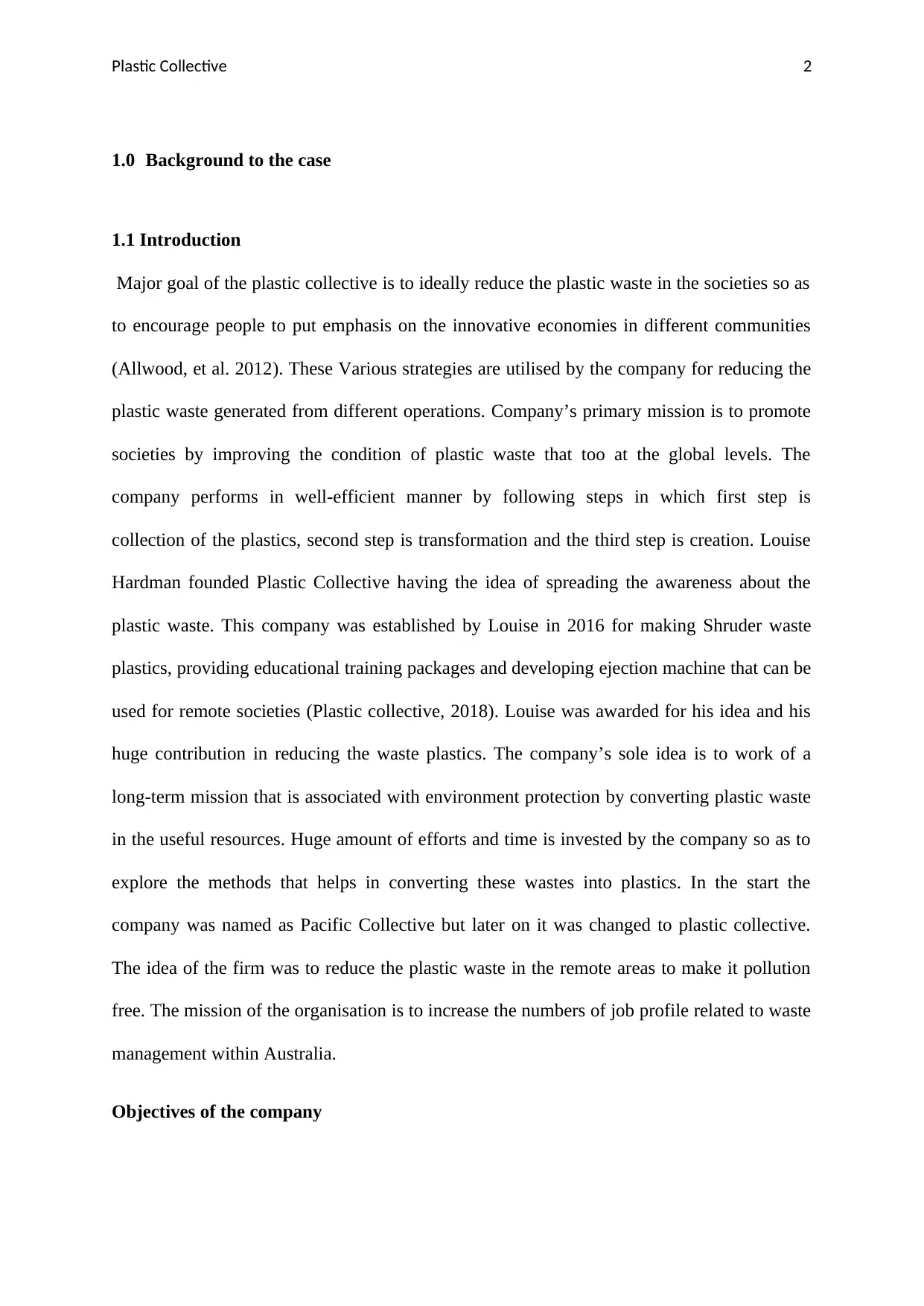
Plastic Collective 2
1.0 Background to the case
1.1 Introduction
Major goal of the plastic collective is to ideally reduce the plastic waste in the societies so as
to encourage people to put emphasis on the innovative economies in different communities
(Allwood, et al. 2012). These Various strategies are utilised by the company for reducing the
plastic waste generated from different operations. Company’s primary mission is to promote
societies by improving the condition of plastic waste that too at the global levels. The
company performs in well-efficient manner by following steps in which first step is
collection of the plastics, second step is transformation and the third step is creation. Louise
Hardman founded Plastic Collective having the idea of spreading the awareness about the
plastic waste. This company was established by Louise in 2016 for making Shruder waste
plastics, providing educational training packages and developing ejection machine that can be
used for remote societies (Plastic collective, 2018). Louise was awarded for his idea and his
huge contribution in reducing the waste plastics. The company’s sole idea is to work of a
long-term mission that is associated with environment protection by converting plastic waste
in the useful resources. Huge amount of efforts and time is invested by the company so as to
explore the methods that helps in converting these wastes into plastics. In the start the
company was named as Pacific Collective but later on it was changed to plastic collective.
The idea of the firm was to reduce the plastic waste in the remote areas to make it pollution
free. The mission of the organisation is to increase the numbers of job profile related to waste
management within Australia.
Objectives of the company
1.0 Background to the case
1.1 Introduction
Major goal of the plastic collective is to ideally reduce the plastic waste in the societies so as
to encourage people to put emphasis on the innovative economies in different communities
(Allwood, et al. 2012). These Various strategies are utilised by the company for reducing the
plastic waste generated from different operations. Company’s primary mission is to promote
societies by improving the condition of plastic waste that too at the global levels. The
company performs in well-efficient manner by following steps in which first step is
collection of the plastics, second step is transformation and the third step is creation. Louise
Hardman founded Plastic Collective having the idea of spreading the awareness about the
plastic waste. This company was established by Louise in 2016 for making Shruder waste
plastics, providing educational training packages and developing ejection machine that can be
used for remote societies (Plastic collective, 2018). Louise was awarded for his idea and his
huge contribution in reducing the waste plastics. The company’s sole idea is to work of a
long-term mission that is associated with environment protection by converting plastic waste
in the useful resources. Huge amount of efforts and time is invested by the company so as to
explore the methods that helps in converting these wastes into plastics. In the start the
company was named as Pacific Collective but later on it was changed to plastic collective.
The idea of the firm was to reduce the plastic waste in the remote areas to make it pollution
free. The mission of the organisation is to increase the numbers of job profile related to waste
management within Australia.
Objectives of the company
⊘ This is a preview!⊘
Do you want full access?
Subscribe today to unlock all pages.

Trusted by 1+ million students worldwide
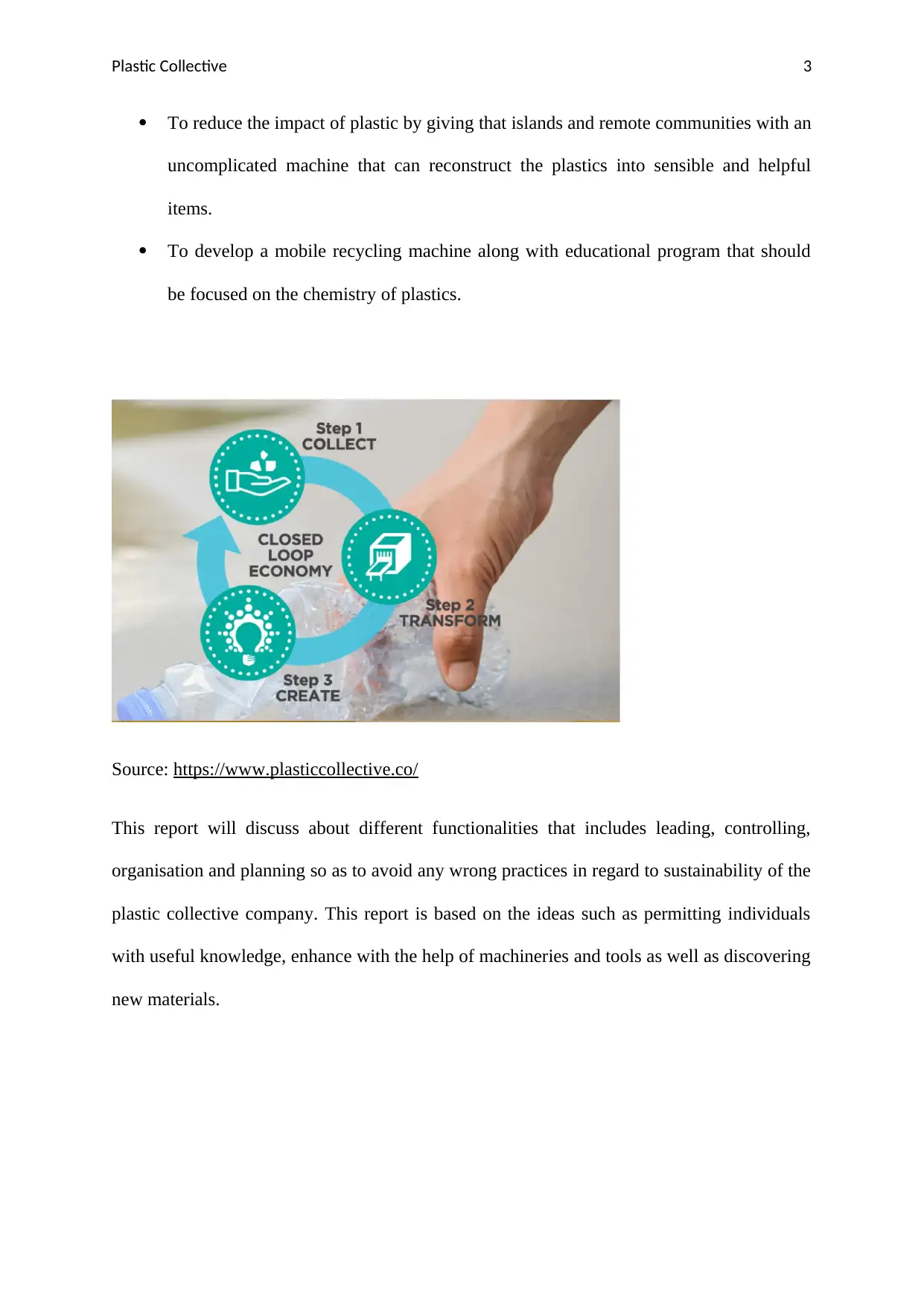
Plastic Collective 3
To reduce the impact of plastic by giving that islands and remote communities with an
uncomplicated machine that can reconstruct the plastics into sensible and helpful
items.
To develop a mobile recycling machine along with educational program that should
be focused on the chemistry of plastics.
Source: https://www.plasticcollective.co/
This report will discuss about different functionalities that includes leading, controlling,
organisation and planning so as to avoid any wrong practices in regard to sustainability of the
plastic collective company. This report is based on the ideas such as permitting individuals
with useful knowledge, enhance with the help of machineries and tools as well as discovering
new materials.
To reduce the impact of plastic by giving that islands and remote communities with an
uncomplicated machine that can reconstruct the plastics into sensible and helpful
items.
To develop a mobile recycling machine along with educational program that should
be focused on the chemistry of plastics.
Source: https://www.plasticcollective.co/
This report will discuss about different functionalities that includes leading, controlling,
organisation and planning so as to avoid any wrong practices in regard to sustainability of the
plastic collective company. This report is based on the ideas such as permitting individuals
with useful knowledge, enhance with the help of machineries and tools as well as discovering
new materials.
Paraphrase This Document
Need a fresh take? Get an instant paraphrase of this document with our AI Paraphraser
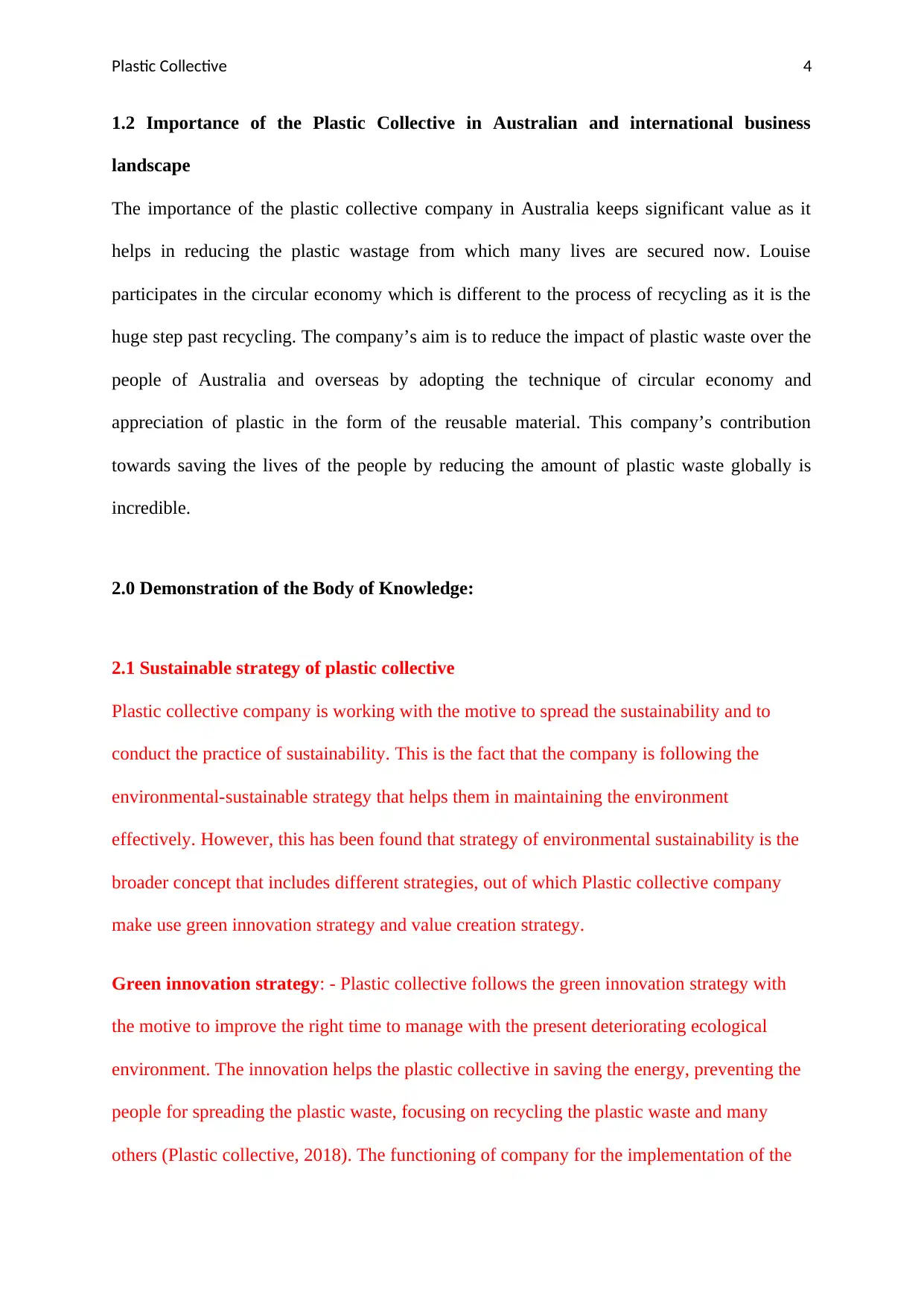
Plastic Collective 4
1.2 Importance of the Plastic Collective in Australian and international business
landscape
The importance of the plastic collective company in Australia keeps significant value as it
helps in reducing the plastic wastage from which many lives are secured now. Louise
participates in the circular economy which is different to the process of recycling as it is the
huge step past recycling. The company’s aim is to reduce the impact of plastic waste over the
people of Australia and overseas by adopting the technique of circular economy and
appreciation of plastic in the form of the reusable material. This company’s contribution
towards saving the lives of the people by reducing the amount of plastic waste globally is
incredible.
2.0 Demonstration of the Body of Knowledge:
2.1 Sustainable strategy of plastic collective
Plastic collective company is working with the motive to spread the sustainability and to
conduct the practice of sustainability. This is the fact that the company is following the
environmental-sustainable strategy that helps them in maintaining the environment
effectively. However, this has been found that strategy of environmental sustainability is the
broader concept that includes different strategies, out of which Plastic collective company
make use green innovation strategy and value creation strategy.
Green innovation strategy: - Plastic collective follows the green innovation strategy with
the motive to improve the right time to manage with the present deteriorating ecological
environment. The innovation helps the plastic collective in saving the energy, preventing the
people for spreading the plastic waste, focusing on recycling the plastic waste and many
others (Plastic collective, 2018). The functioning of company for the implementation of the
1.2 Importance of the Plastic Collective in Australian and international business
landscape
The importance of the plastic collective company in Australia keeps significant value as it
helps in reducing the plastic wastage from which many lives are secured now. Louise
participates in the circular economy which is different to the process of recycling as it is the
huge step past recycling. The company’s aim is to reduce the impact of plastic waste over the
people of Australia and overseas by adopting the technique of circular economy and
appreciation of plastic in the form of the reusable material. This company’s contribution
towards saving the lives of the people by reducing the amount of plastic waste globally is
incredible.
2.0 Demonstration of the Body of Knowledge:
2.1 Sustainable strategy of plastic collective
Plastic collective company is working with the motive to spread the sustainability and to
conduct the practice of sustainability. This is the fact that the company is following the
environmental-sustainable strategy that helps them in maintaining the environment
effectively. However, this has been found that strategy of environmental sustainability is the
broader concept that includes different strategies, out of which Plastic collective company
make use green innovation strategy and value creation strategy.
Green innovation strategy: - Plastic collective follows the green innovation strategy with
the motive to improve the right time to manage with the present deteriorating ecological
environment. The innovation helps the plastic collective in saving the energy, preventing the
people for spreading the plastic waste, focusing on recycling the plastic waste and many
others (Plastic collective, 2018). The functioning of company for the implementation of the
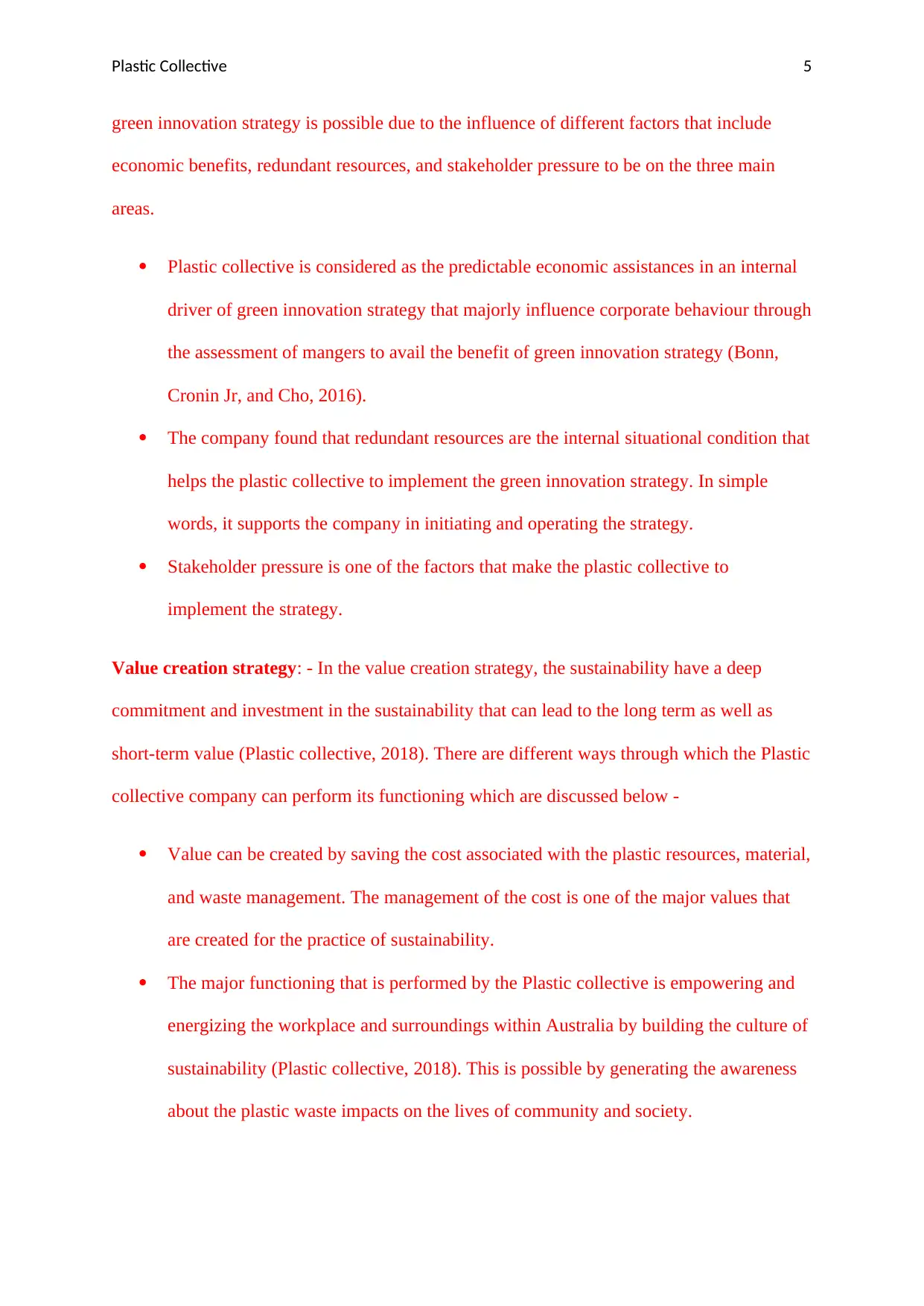
Plastic Collective 5
green innovation strategy is possible due to the influence of different factors that include
economic benefits, redundant resources, and stakeholder pressure to be on the three main
areas.
Plastic collective is considered as the predictable economic assistances in an internal
driver of green innovation strategy that majorly influence corporate behaviour through
the assessment of mangers to avail the benefit of green innovation strategy (Bonn,
Cronin Jr, and Cho, 2016).
The company found that redundant resources are the internal situational condition that
helps the plastic collective to implement the green innovation strategy. In simple
words, it supports the company in initiating and operating the strategy.
Stakeholder pressure is one of the factors that make the plastic collective to
implement the strategy.
Value creation strategy: - In the value creation strategy, the sustainability have a deep
commitment and investment in the sustainability that can lead to the long term as well as
short-term value (Plastic collective, 2018). There are different ways through which the Plastic
collective company can perform its functioning which are discussed below -
Value can be created by saving the cost associated with the plastic resources, material,
and waste management. The management of the cost is one of the major values that
are created for the practice of sustainability.
The major functioning that is performed by the Plastic collective is empowering and
energizing the workplace and surroundings within Australia by building the culture of
sustainability (Plastic collective, 2018). This is possible by generating the awareness
about the plastic waste impacts on the lives of community and society.
green innovation strategy is possible due to the influence of different factors that include
economic benefits, redundant resources, and stakeholder pressure to be on the three main
areas.
Plastic collective is considered as the predictable economic assistances in an internal
driver of green innovation strategy that majorly influence corporate behaviour through
the assessment of mangers to avail the benefit of green innovation strategy (Bonn,
Cronin Jr, and Cho, 2016).
The company found that redundant resources are the internal situational condition that
helps the plastic collective to implement the green innovation strategy. In simple
words, it supports the company in initiating and operating the strategy.
Stakeholder pressure is one of the factors that make the plastic collective to
implement the strategy.
Value creation strategy: - In the value creation strategy, the sustainability have a deep
commitment and investment in the sustainability that can lead to the long term as well as
short-term value (Plastic collective, 2018). There are different ways through which the Plastic
collective company can perform its functioning which are discussed below -
Value can be created by saving the cost associated with the plastic resources, material,
and waste management. The management of the cost is one of the major values that
are created for the practice of sustainability.
The major functioning that is performed by the Plastic collective is empowering and
energizing the workplace and surroundings within Australia by building the culture of
sustainability (Plastic collective, 2018). This is possible by generating the awareness
about the plastic waste impacts on the lives of community and society.
⊘ This is a preview!⊘
Do you want full access?
Subscribe today to unlock all pages.

Trusted by 1+ million students worldwide
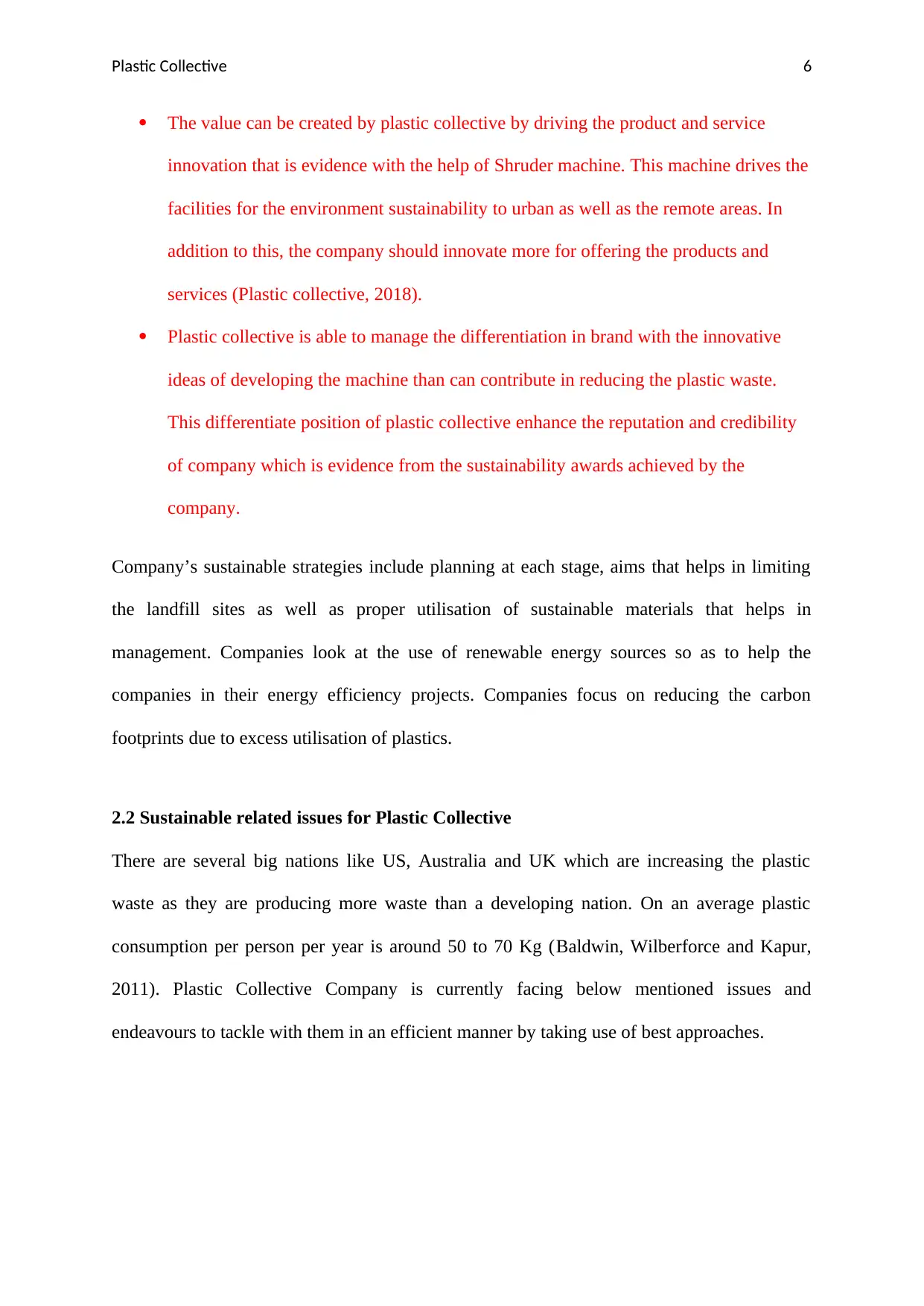
Plastic Collective 6
The value can be created by plastic collective by driving the product and service
innovation that is evidence with the help of Shruder machine. This machine drives the
facilities for the environment sustainability to urban as well as the remote areas. In
addition to this, the company should innovate more for offering the products and
services (Plastic collective, 2018).
Plastic collective is able to manage the differentiation in brand with the innovative
ideas of developing the machine than can contribute in reducing the plastic waste.
This differentiate position of plastic collective enhance the reputation and credibility
of company which is evidence from the sustainability awards achieved by the
company.
Company’s sustainable strategies include planning at each stage, aims that helps in limiting
the landfill sites as well as proper utilisation of sustainable materials that helps in
management. Companies look at the use of renewable energy sources so as to help the
companies in their energy efficiency projects. Companies focus on reducing the carbon
footprints due to excess utilisation of plastics.
2.2 Sustainable related issues for Plastic Collective
There are several big nations like US, Australia and UK which are increasing the plastic
waste as they are producing more waste than a developing nation. On an average plastic
consumption per person per year is around 50 to 70 Kg (Baldwin, Wilberforce and Kapur,
2011). Plastic Collective Company is currently facing below mentioned issues and
endeavours to tackle with them in an efficient manner by taking use of best approaches.
The value can be created by plastic collective by driving the product and service
innovation that is evidence with the help of Shruder machine. This machine drives the
facilities for the environment sustainability to urban as well as the remote areas. In
addition to this, the company should innovate more for offering the products and
services (Plastic collective, 2018).
Plastic collective is able to manage the differentiation in brand with the innovative
ideas of developing the machine than can contribute in reducing the plastic waste.
This differentiate position of plastic collective enhance the reputation and credibility
of company which is evidence from the sustainability awards achieved by the
company.
Company’s sustainable strategies include planning at each stage, aims that helps in limiting
the landfill sites as well as proper utilisation of sustainable materials that helps in
management. Companies look at the use of renewable energy sources so as to help the
companies in their energy efficiency projects. Companies focus on reducing the carbon
footprints due to excess utilisation of plastics.
2.2 Sustainable related issues for Plastic Collective
There are several big nations like US, Australia and UK which are increasing the plastic
waste as they are producing more waste than a developing nation. On an average plastic
consumption per person per year is around 50 to 70 Kg (Baldwin, Wilberforce and Kapur,
2011). Plastic Collective Company is currently facing below mentioned issues and
endeavours to tackle with them in an efficient manner by taking use of best approaches.
Paraphrase This Document
Need a fresh take? Get an instant paraphrase of this document with our AI Paraphraser
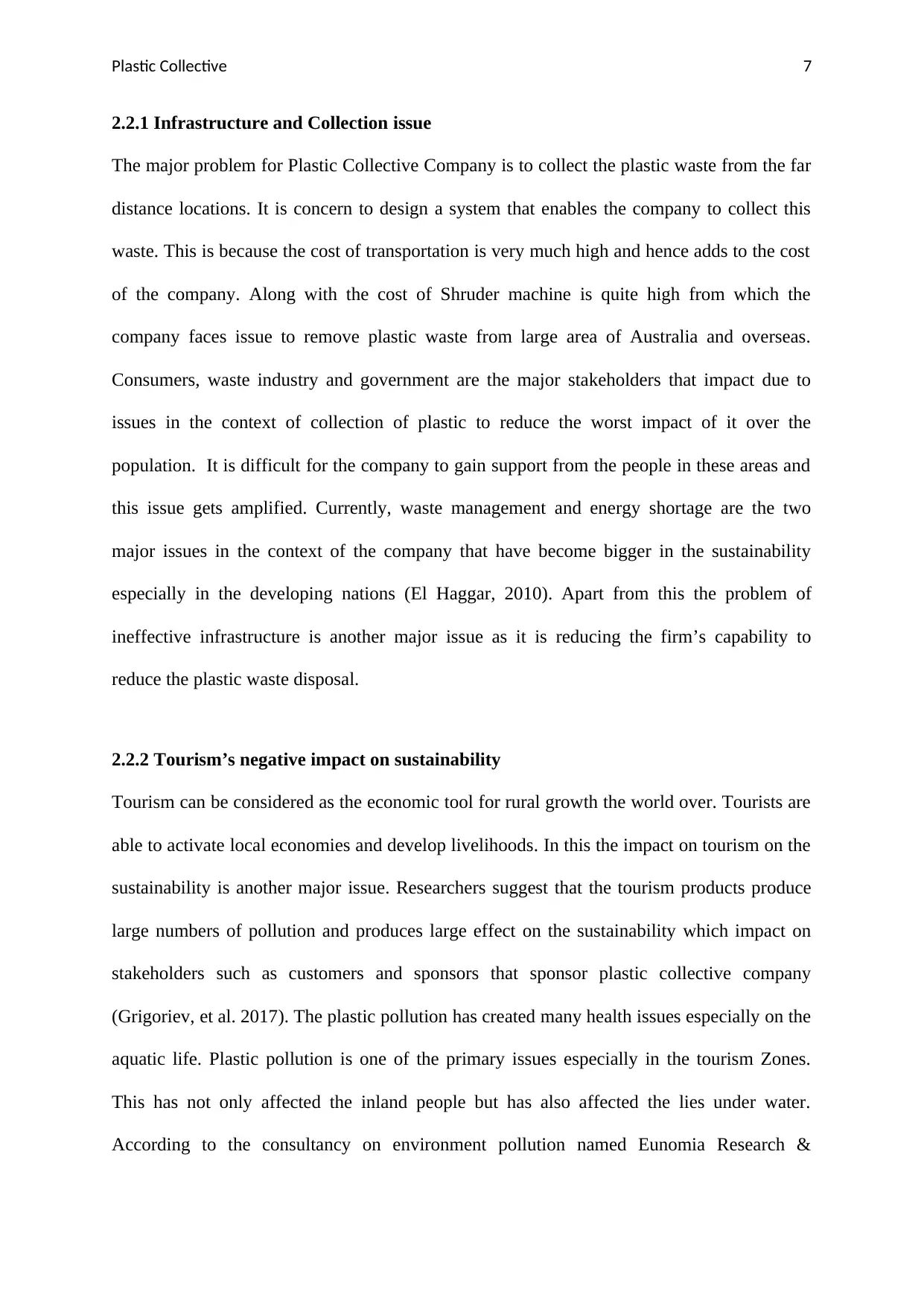
Plastic Collective 7
2.2.1 Infrastructure and Collection issue
The major problem for Plastic Collective Company is to collect the plastic waste from the far
distance locations. It is concern to design a system that enables the company to collect this
waste. This is because the cost of transportation is very much high and hence adds to the cost
of the company. Along with the cost of Shruder machine is quite high from which the
company faces issue to remove plastic waste from large area of Australia and overseas.
Consumers, waste industry and government are the major stakeholders that impact due to
issues in the context of collection of plastic to reduce the worst impact of it over the
population. It is difficult for the company to gain support from the people in these areas and
this issue gets amplified. Currently, waste management and energy shortage are the two
major issues in the context of the company that have become bigger in the sustainability
especially in the developing nations (El Haggar, 2010). Apart from this the problem of
ineffective infrastructure is another major issue as it is reducing the firm’s capability to
reduce the plastic waste disposal.
2.2.2 Tourism’s negative impact on sustainability
Tourism can be considered as the economic tool for rural growth the world over. Tourists are
able to activate local economies and develop livelihoods. In this the impact on tourism on the
sustainability is another major issue. Researchers suggest that the tourism products produce
large numbers of pollution and produces large effect on the sustainability which impact on
stakeholders such as customers and sponsors that sponsor plastic collective company
(Grigoriev, et al. 2017). The plastic pollution has created many health issues especially on the
aquatic life. Plastic pollution is one of the primary issues especially in the tourism Zones.
This has not only affected the inland people but has also affected the lies under water.
According to the consultancy on environment pollution named Eunomia Research &
2.2.1 Infrastructure and Collection issue
The major problem for Plastic Collective Company is to collect the plastic waste from the far
distance locations. It is concern to design a system that enables the company to collect this
waste. This is because the cost of transportation is very much high and hence adds to the cost
of the company. Along with the cost of Shruder machine is quite high from which the
company faces issue to remove plastic waste from large area of Australia and overseas.
Consumers, waste industry and government are the major stakeholders that impact due to
issues in the context of collection of plastic to reduce the worst impact of it over the
population. It is difficult for the company to gain support from the people in these areas and
this issue gets amplified. Currently, waste management and energy shortage are the two
major issues in the context of the company that have become bigger in the sustainability
especially in the developing nations (El Haggar, 2010). Apart from this the problem of
ineffective infrastructure is another major issue as it is reducing the firm’s capability to
reduce the plastic waste disposal.
2.2.2 Tourism’s negative impact on sustainability
Tourism can be considered as the economic tool for rural growth the world over. Tourists are
able to activate local economies and develop livelihoods. In this the impact on tourism on the
sustainability is another major issue. Researchers suggest that the tourism products produce
large numbers of pollution and produces large effect on the sustainability which impact on
stakeholders such as customers and sponsors that sponsor plastic collective company
(Grigoriev, et al. 2017). The plastic pollution has created many health issues especially on the
aquatic life. Plastic pollution is one of the primary issues especially in the tourism Zones.
This has not only affected the inland people but has also affected the lies under water.
According to the consultancy on environment pollution named Eunomia Research &
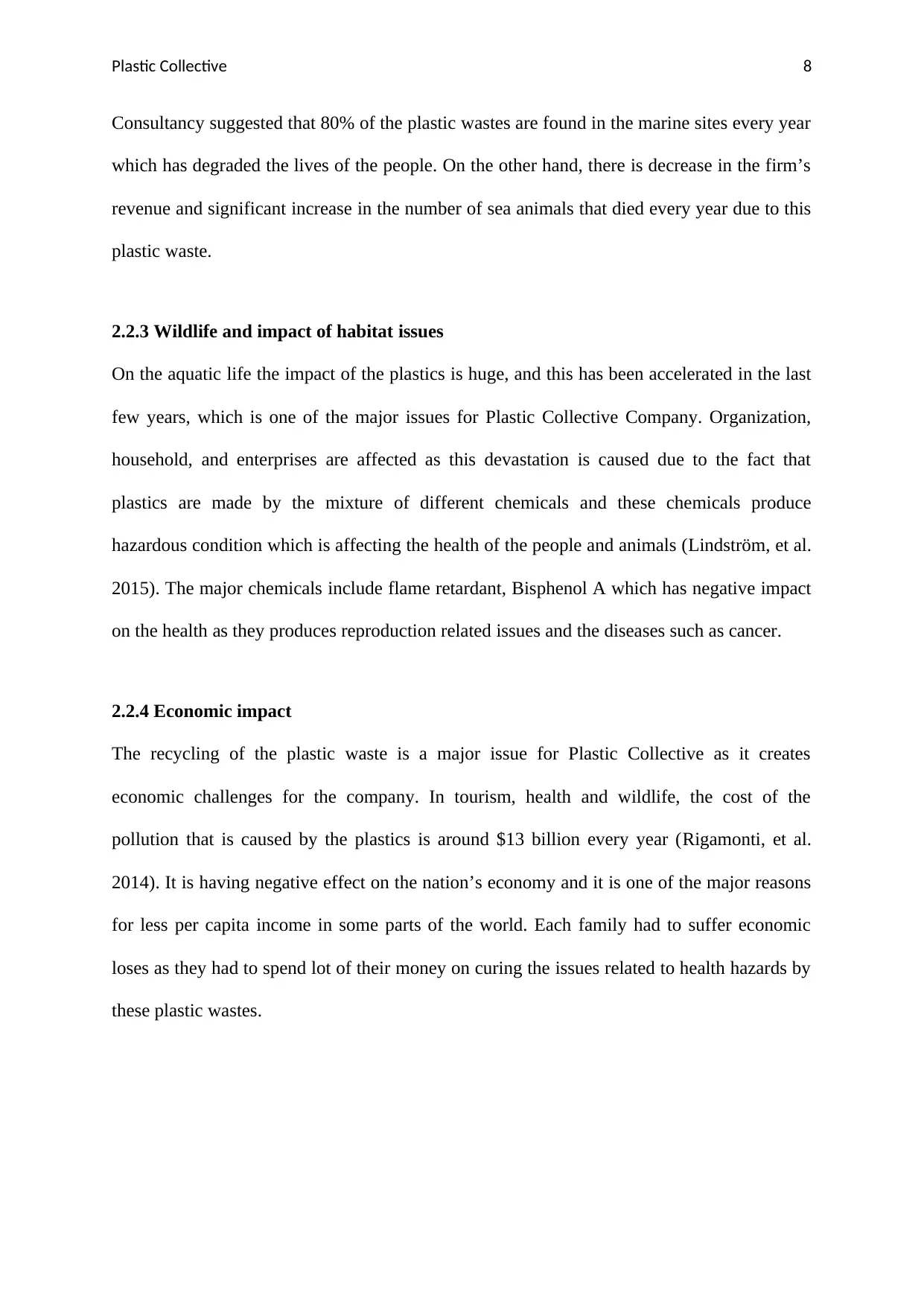
Plastic Collective 8
Consultancy suggested that 80% of the plastic wastes are found in the marine sites every year
which has degraded the lives of the people. On the other hand, there is decrease in the firm’s
revenue and significant increase in the number of sea animals that died every year due to this
plastic waste.
2.2.3 Wildlife and impact of habitat issues
On the aquatic life the impact of the plastics is huge, and this has been accelerated in the last
few years, which is one of the major issues for Plastic Collective Company. Organization,
household, and enterprises are affected as this devastation is caused due to the fact that
plastics are made by the mixture of different chemicals and these chemicals produce
hazardous condition which is affecting the health of the people and animals (Lindström, et al.
2015). The major chemicals include flame retardant, Bisphenol A which has negative impact
on the health as they produces reproduction related issues and the diseases such as cancer.
2.2.4 Economic impact
The recycling of the plastic waste is a major issue for Plastic Collective as it creates
economic challenges for the company. In tourism, health and wildlife, the cost of the
pollution that is caused by the plastics is around $13 billion every year (Rigamonti, et al.
2014). It is having negative effect on the nation’s economy and it is one of the major reasons
for less per capita income in some parts of the world. Each family had to suffer economic
loses as they had to spend lot of their money on curing the issues related to health hazards by
these plastic wastes.
Consultancy suggested that 80% of the plastic wastes are found in the marine sites every year
which has degraded the lives of the people. On the other hand, there is decrease in the firm’s
revenue and significant increase in the number of sea animals that died every year due to this
plastic waste.
2.2.3 Wildlife and impact of habitat issues
On the aquatic life the impact of the plastics is huge, and this has been accelerated in the last
few years, which is one of the major issues for Plastic Collective Company. Organization,
household, and enterprises are affected as this devastation is caused due to the fact that
plastics are made by the mixture of different chemicals and these chemicals produce
hazardous condition which is affecting the health of the people and animals (Lindström, et al.
2015). The major chemicals include flame retardant, Bisphenol A which has negative impact
on the health as they produces reproduction related issues and the diseases such as cancer.
2.2.4 Economic impact
The recycling of the plastic waste is a major issue for Plastic Collective as it creates
economic challenges for the company. In tourism, health and wildlife, the cost of the
pollution that is caused by the plastics is around $13 billion every year (Rigamonti, et al.
2014). It is having negative effect on the nation’s economy and it is one of the major reasons
for less per capita income in some parts of the world. Each family had to suffer economic
loses as they had to spend lot of their money on curing the issues related to health hazards by
these plastic wastes.
⊘ This is a preview!⊘
Do you want full access?
Subscribe today to unlock all pages.

Trusted by 1+ million students worldwide
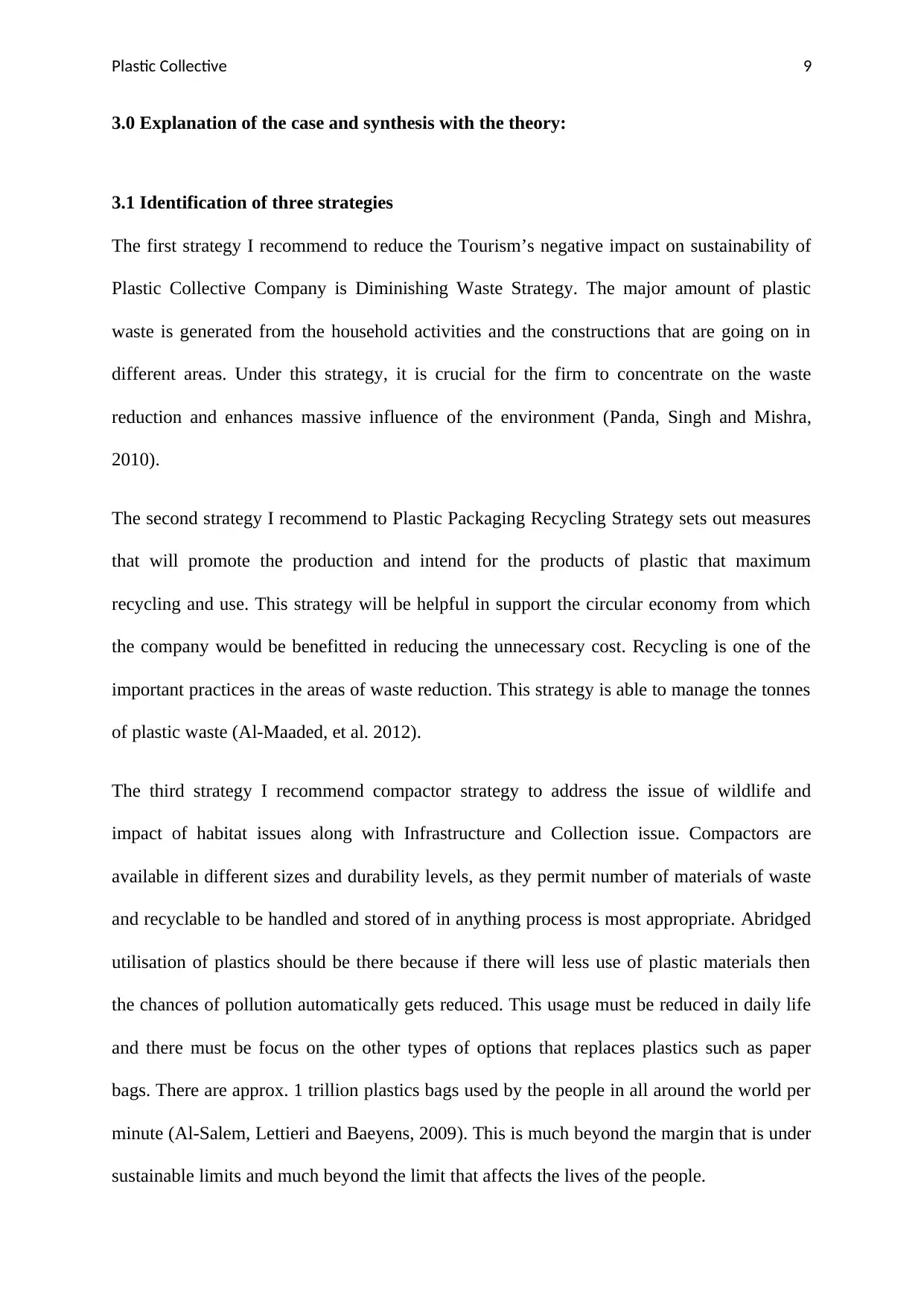
Plastic Collective 9
3.0 Explanation of the case and synthesis with the theory:
3.1 Identification of three strategies
The first strategy I recommend to reduce the Tourism’s negative impact on sustainability of
Plastic Collective Company is Diminishing Waste Strategy. The major amount of plastic
waste is generated from the household activities and the constructions that are going on in
different areas. Under this strategy, it is crucial for the firm to concentrate on the waste
reduction and enhances massive influence of the environment (Panda, Singh and Mishra,
2010).
The second strategy I recommend to Plastic Packaging Recycling Strategy sets out measures
that will promote the production and intend for the products of plastic that maximum
recycling and use. This strategy will be helpful in support the circular economy from which
the company would be benefitted in reducing the unnecessary cost. Recycling is one of the
important practices in the areas of waste reduction. This strategy is able to manage the tonnes
of plastic waste (Al-Maaded, et al. 2012).
The third strategy I recommend compactor strategy to address the issue of wildlife and
impact of habitat issues along with Infrastructure and Collection issue. Compactors are
available in different sizes and durability levels, as they permit number of materials of waste
and recyclable to be handled and stored of in anything process is most appropriate. Abridged
utilisation of plastics should be there because if there will less use of plastic materials then
the chances of pollution automatically gets reduced. This usage must be reduced in daily life
and there must be focus on the other types of options that replaces plastics such as paper
bags. There are approx. 1 trillion plastics bags used by the people in all around the world per
minute (Al-Salem, Lettieri and Baeyens, 2009). This is much beyond the margin that is under
sustainable limits and much beyond the limit that affects the lives of the people.
3.0 Explanation of the case and synthesis with the theory:
3.1 Identification of three strategies
The first strategy I recommend to reduce the Tourism’s negative impact on sustainability of
Plastic Collective Company is Diminishing Waste Strategy. The major amount of plastic
waste is generated from the household activities and the constructions that are going on in
different areas. Under this strategy, it is crucial for the firm to concentrate on the waste
reduction and enhances massive influence of the environment (Panda, Singh and Mishra,
2010).
The second strategy I recommend to Plastic Packaging Recycling Strategy sets out measures
that will promote the production and intend for the products of plastic that maximum
recycling and use. This strategy will be helpful in support the circular economy from which
the company would be benefitted in reducing the unnecessary cost. Recycling is one of the
important practices in the areas of waste reduction. This strategy is able to manage the tonnes
of plastic waste (Al-Maaded, et al. 2012).
The third strategy I recommend compactor strategy to address the issue of wildlife and
impact of habitat issues along with Infrastructure and Collection issue. Compactors are
available in different sizes and durability levels, as they permit number of materials of waste
and recyclable to be handled and stored of in anything process is most appropriate. Abridged
utilisation of plastics should be there because if there will less use of plastic materials then
the chances of pollution automatically gets reduced. This usage must be reduced in daily life
and there must be focus on the other types of options that replaces plastics such as paper
bags. There are approx. 1 trillion plastics bags used by the people in all around the world per
minute (Al-Salem, Lettieri and Baeyens, 2009). This is much beyond the margin that is under
sustainable limits and much beyond the limit that affects the lives of the people.
Paraphrase This Document
Need a fresh take? Get an instant paraphrase of this document with our AI Paraphraser
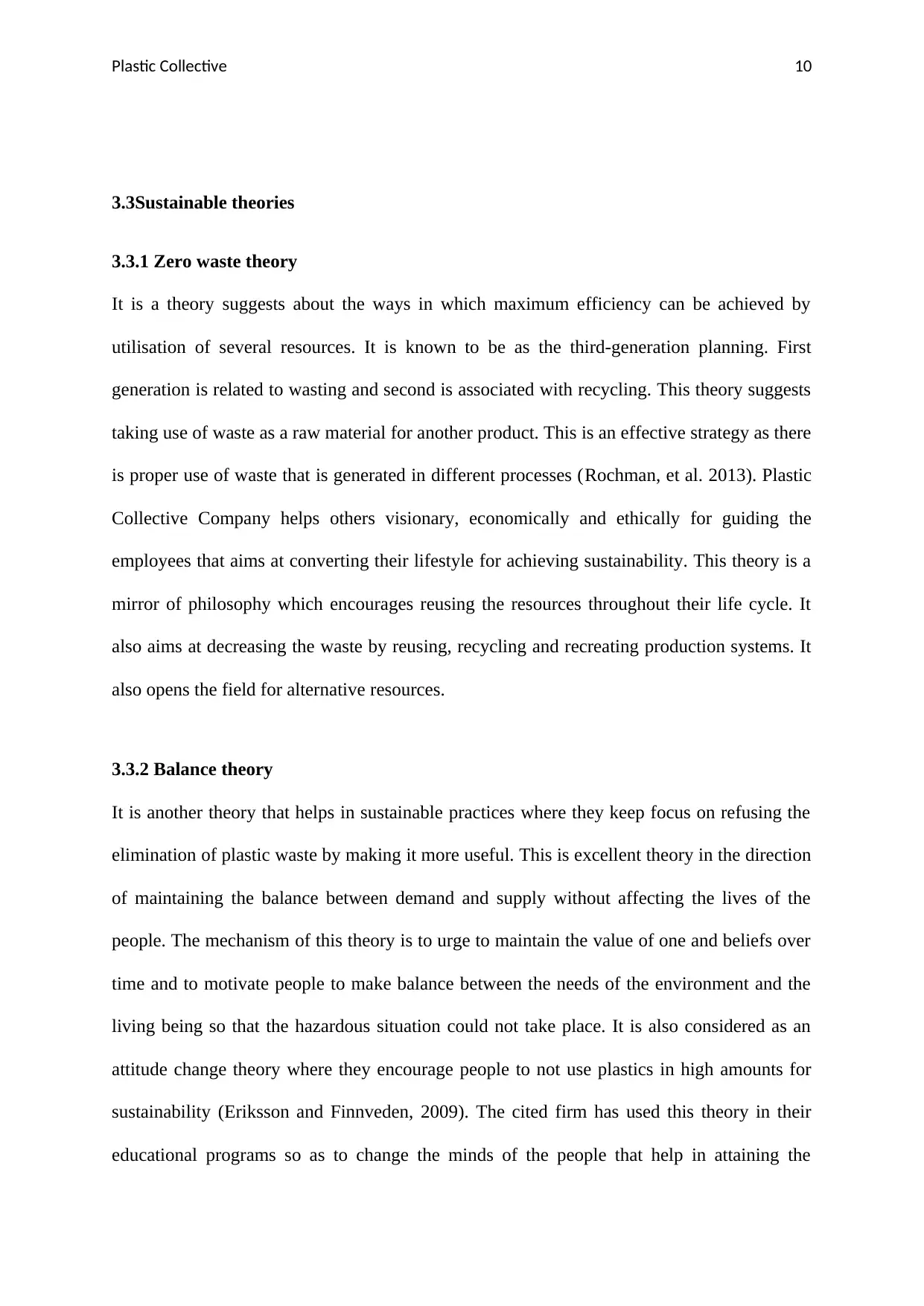
Plastic Collective 10
3.3Sustainable theories
3.3.1 Zero waste theory
It is a theory suggests about the ways in which maximum efficiency can be achieved by
utilisation of several resources. It is known to be as the third-generation planning. First
generation is related to wasting and second is associated with recycling. This theory suggests
taking use of waste as a raw material for another product. This is an effective strategy as there
is proper use of waste that is generated in different processes (Rochman, et al. 2013). Plastic
Collective Company helps others visionary, economically and ethically for guiding the
employees that aims at converting their lifestyle for achieving sustainability. This theory is a
mirror of philosophy which encourages reusing the resources throughout their life cycle. It
also aims at decreasing the waste by reusing, recycling and recreating production systems. It
also opens the field for alternative resources.
3.3.2 Balance theory
It is another theory that helps in sustainable practices where they keep focus on refusing the
elimination of plastic waste by making it more useful. This is excellent theory in the direction
of maintaining the balance between demand and supply without affecting the lives of the
people. The mechanism of this theory is to urge to maintain the value of one and beliefs over
time and to motivate people to make balance between the needs of the environment and the
living being so that the hazardous situation could not take place. It is also considered as an
attitude change theory where they encourage people to not use plastics in high amounts for
sustainability (Eriksson and Finnveden, 2009). The cited firm has used this theory in their
educational programs so as to change the minds of the people that help in attaining the
3.3Sustainable theories
3.3.1 Zero waste theory
It is a theory suggests about the ways in which maximum efficiency can be achieved by
utilisation of several resources. It is known to be as the third-generation planning. First
generation is related to wasting and second is associated with recycling. This theory suggests
taking use of waste as a raw material for another product. This is an effective strategy as there
is proper use of waste that is generated in different processes (Rochman, et al. 2013). Plastic
Collective Company helps others visionary, economically and ethically for guiding the
employees that aims at converting their lifestyle for achieving sustainability. This theory is a
mirror of philosophy which encourages reusing the resources throughout their life cycle. It
also aims at decreasing the waste by reusing, recycling and recreating production systems. It
also opens the field for alternative resources.
3.3.2 Balance theory
It is another theory that helps in sustainable practices where they keep focus on refusing the
elimination of plastic waste by making it more useful. This is excellent theory in the direction
of maintaining the balance between demand and supply without affecting the lives of the
people. The mechanism of this theory is to urge to maintain the value of one and beliefs over
time and to motivate people to make balance between the needs of the environment and the
living being so that the hazardous situation could not take place. It is also considered as an
attitude change theory where they encourage people to not use plastics in high amounts for
sustainability (Eriksson and Finnveden, 2009). The cited firm has used this theory in their
educational programs so as to change the minds of the people that help in attaining the
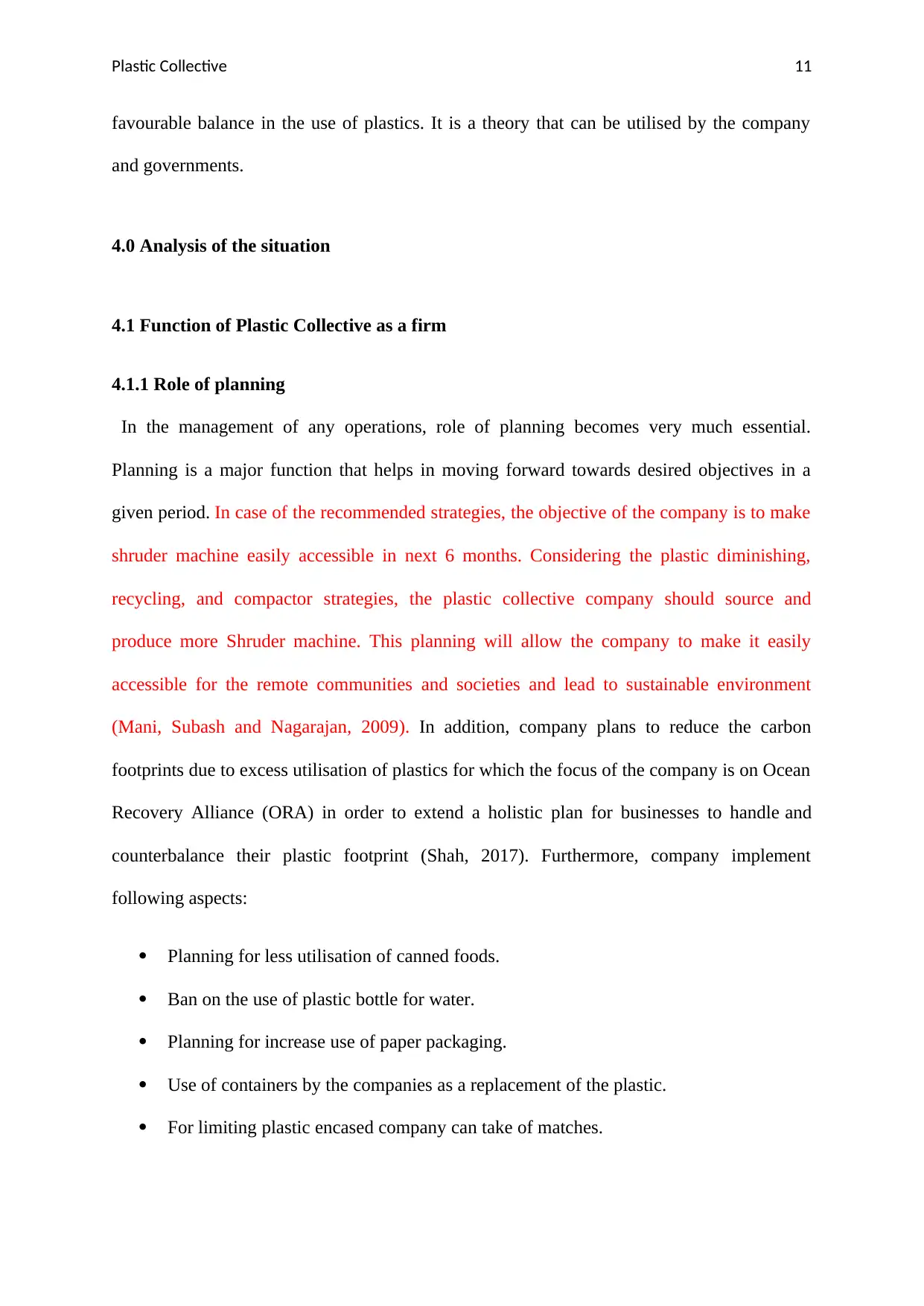
Plastic Collective 11
favourable balance in the use of plastics. It is a theory that can be utilised by the company
and governments.
4.0 Analysis of the situation
4.1 Function of Plastic Collective as a firm
4.1.1 Role of planning
In the management of any operations, role of planning becomes very much essential.
Planning is a major function that helps in moving forward towards desired objectives in a
given period. In case of the recommended strategies, the objective of the company is to make
shruder machine easily accessible in next 6 months. Considering the plastic diminishing,
recycling, and compactor strategies, the plastic collective company should source and
produce more Shruder machine. This planning will allow the company to make it easily
accessible for the remote communities and societies and lead to sustainable environment
(Mani, Subash and Nagarajan, 2009). In addition, company plans to reduce the carbon
footprints due to excess utilisation of plastics for which the focus of the company is on Ocean
Recovery Alliance (ORA) in order to extend a holistic plan for businesses to handle and
counterbalance their plastic footprint (Shah, 2017). Furthermore, company implement
following aspects:
Planning for less utilisation of canned foods.
Ban on the use of plastic bottle for water.
Planning for increase use of paper packaging.
Use of containers by the companies as a replacement of the plastic.
For limiting plastic encased company can take of matches.
favourable balance in the use of plastics. It is a theory that can be utilised by the company
and governments.
4.0 Analysis of the situation
4.1 Function of Plastic Collective as a firm
4.1.1 Role of planning
In the management of any operations, role of planning becomes very much essential.
Planning is a major function that helps in moving forward towards desired objectives in a
given period. In case of the recommended strategies, the objective of the company is to make
shruder machine easily accessible in next 6 months. Considering the plastic diminishing,
recycling, and compactor strategies, the plastic collective company should source and
produce more Shruder machine. This planning will allow the company to make it easily
accessible for the remote communities and societies and lead to sustainable environment
(Mani, Subash and Nagarajan, 2009). In addition, company plans to reduce the carbon
footprints due to excess utilisation of plastics for which the focus of the company is on Ocean
Recovery Alliance (ORA) in order to extend a holistic plan for businesses to handle and
counterbalance their plastic footprint (Shah, 2017). Furthermore, company implement
following aspects:
Planning for less utilisation of canned foods.
Ban on the use of plastic bottle for water.
Planning for increase use of paper packaging.
Use of containers by the companies as a replacement of the plastic.
For limiting plastic encased company can take of matches.
⊘ This is a preview!⊘
Do you want full access?
Subscribe today to unlock all pages.

Trusted by 1+ million students worldwide
1 out of 19
Related Documents
Your All-in-One AI-Powered Toolkit for Academic Success.
+13062052269
info@desklib.com
Available 24*7 on WhatsApp / Email
![[object Object]](/_next/static/media/star-bottom.7253800d.svg)
Unlock your academic potential
Copyright © 2020–2025 A2Z Services. All Rights Reserved. Developed and managed by ZUCOL.


